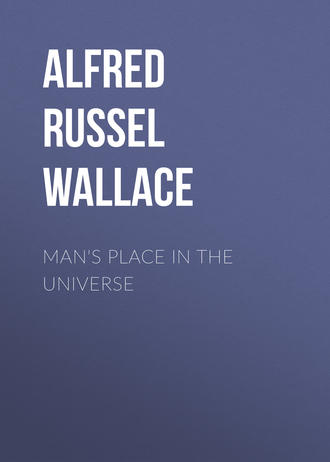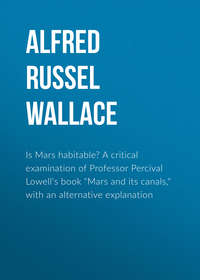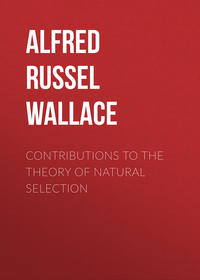 полная версия
полная версияПолная версия
Man's Place in the Universe
But if this annular form with some kind of central nucleus, often very large, is produced under certain conditions by the action of the ordinary laws of motion upon more or less extensive masses of discrete matter, why may not the same laws acting upon similar matter once dispersed over the whole extent of the existing stellar universe, or even beyond what are now its farthest limits, have led to the aggregation of the vast annular formation of the Milky Way, with all the subordinate centres of concentration or dispersal to be found within or around it? And if this is a reasonable conception, may we not hope that by a concentration of attention upon a few of the best marked and most favourably situated annular and spiral systems, sufficient knowledge of their internal motions may be obtained which may serve as a guide to the kind of motion we may expect to find in the great galactic ring and its subordinate stars? We may then perhaps discover which now seem so erratic, are really all parts of a series of orbital movements limited and controlled by the forces of the great system to which they belong, so that, if not mathematically stable, they may yet be sufficiently so to endure for some thousand millions of years.
It is a suggestive fact that the calculated position of the 'solar apex'—the point towards which our sun appears to move—is now found to be much more nearly in the plane of the Milky Way than the position first assigned to it, and Professor Newcomb adopts, as most likely to be accurate, a point near the bright star Vega in the constellation Lyra. Other calculators have placed it still farther east, while Rancken and Otto Stumpe assign it a position actually in the Milky Way; and Mr. G.C. Bompas concludes that the sun's plane of motion nearly coincides with that of the Galaxy. M. Rancken found that 106 stars near the Milky Way showed, in their very small proper motions, a drift along it in a direction from Cassiopeiæ towards Orion, and this, it is supposed, may be partly due to our sun's motion in an opposite direction.
In many other parts of the heavens there are groups of stars which have almost identical proper motions—a phenomenon which the late R.A. Proctor termed 'star-drift'; and he especially pointed out that five of the stars of the Great Bear were all drifting in the same direction; and although this has been denied by later writers, Professor Newcomb, in his recent book on The Stars, declares that Proctor was right, and explains that the error of his critics was due to not making allowance for the divergence of the circles of right ascension. The Pleiades are another group, the stars of which drift in the same direction, and it is a most suggestive fact that photographs now show this cluster to be embedded in a vast nebula, which, therefore, has also a proper motion; but some of the smaller stars do not partake of it. Three stars in Cassiopeiæ also move together, and no doubt many other similarly connected groups remain to be discovered.
These facts have a very important bearing on the question of the motion of our sun in space. For this motion has been determined by comparing the motions of large numbers of stars which are assumed to be wholly independent of each other, and to move, as it were, at random. Miss A.M. Clerke, in her System of the Stars, puts this point very clearly, as follows: 'For the assumption that the absolute movements of the stars have no preference for one direction over another, forms the basis of all investigations hitherto conducted into the translatory advance of the solar system. The little fabric of laboriously acquired knowledge regarding it at once crumbles if that basis has to be removed. In all investigations of the sun's movement, the movements of the stars have been regarded as casual irregularities; should they prove to be in any visible degree systematic, the mode of treatment adopted (and there is no other at present open to us) becomes invalid, and its results null and void. The point is then of singular interest, and the evidence bearing upon it deserves our utmost attention.'
Mr. W.H.S. Monck, a well-known astronomer, takes the same view. He says: 'The proof of this motion rests on the assumption that if we take a sufficient number of stars, their real motions in all directions will be equal, and that therefore the apparent preponderances which we observe in particular directions result from the real motion of the sun. But there is no impossibility in a systematic motion of the majority of the stars used in these researches which might reconcile the observed facts with a motionless sun. And, in the second place, if the sun is not in the exact centre of gravity of the universe, we might expect him to be moving in an orbit around this centre of gravity, and our observations on his actual motion are not sufficiently numerous or accurate to enable us to affirm that he is moving in a right line rather than such an orbit.'
Now this 'systematic motion,' which would render all calculations as to the sun's motion inaccurate or even altogether worthless, is by many astronomers held to be an observed reality. The star-drift, first pointed out by Proctor, has been shown to exist in many other groups of stars, while the curious arrangements of stars all over the heavens in straight lines, or regular curves, or spirals, strongly suggests a wide extension of the same kind of relation. But even more extensive systematic movements have been observed or suggested by astronomers. Sir D. Gill, by an extensive research, believes that he has found indications of a rotation of the brighter fixed stars as a whole in regard to the fainter fixed stars as a whole. Mr. Maxwell Hall has also found indications of a movement of a large group of stars, including our sun, around a common centre, situated in a direction towards Epsilon Andromedæ, and at a distance of about 490 years of light-travel. These last two motions are not yet established; but they seem to prove two important facts—(a) that eminent astronomers believe that some systematic motions must exist among the stars, or they would not devote so much labour to the search for them; and (b) that extensive systematic motions of some kind do exist, or even these results would not have been obtained.
Mr. W.W. Campbell, of the Lick Observatory, thus remarks on the uncertainty of determinations of the sun's motions: 'The motion of the solar system is a purely relative quantity. It refers to specified groups of stars. The results for various groups may differ widely, and all be correct. It would be easy to select a group of stars with reference to which the solar motion would be reversed 180° from the values assigned above' (Astrophysical Journal, vol. xiii. p. 87. 1901).
It must be remembered that, within a uniform cluster of stars, each moving round the common centre of gravity of the whole cluster, Kepler's laws do not prevail, the law being that the angular velocities are all identical, so that the more distant stars move faster than those nearer the centre, subject to modifications, however, due to the varying density of the cluster. But if the cluster is nearly globular, there must be stars moving round the centre in every plane, and this would lead to apparent motions in many directions as viewed by us, although those which were moving in the same plane as ourselves would, when compared with remote stars outside the cluster, appear to be all moving in the same direction and at the same rate, forming, in fact, one of those drifting systems of stars already referred to. Again, if in the process of formation of our cluster, smaller aggregations already having a rotatory motion were drawn into it, this might lead to their revolving in an opposite direction to those which were formed from the original nebula, thus increasing the diversities of apparent motion.
The evidence now briefly set forth fully justifies, I submit, the remarks as to the statements of my astronomical critics at the beginning of this section. They have both given the accepted views as to direction and rate of movement of our sun without any qualification whatever, as if they were astronomical facts of the same certainty and the same degree of accuracy as the sun's distance from the earth; and they will assuredly have been so understood by the great body of non-mathematical readers. It appears, however, if the authorities I have quoted are right, that the whole calculation rests upon certain assumptions, which are certainly to some extent, and may be to a very large extent, erroneous. This is my reply to one part of their criticism.
In the next place, they both assert, or imply, not only that the sun's motion is now in a straight line, but that it has been in a straight line from some enormously remote period when it first entered the stellar system on one side, and will so continue to move till it reaches the utmost bounds of that system on the other side. And this is stated by them both, not as a possibility, but as a certainty. They use such terms as 'must' and 'will be,' leaving no room for any doubt whatever. But such a result implies the abrogation of the law of gravitation, since under its action motion in a straight line in the midst of thousands or millions of suns of various sizes is an absolute impossibility; while it also implies that the sun must have been started on its course from some other system outside the Milky Way, with such a precise determination of direction as not to collide with, or even make a near approach to, any one of the suns or clusters of suns, or vast nebulous masses, during its passage through the very midst of the stellar universe.
This is my reply to the main point of their criticism, and I think I am justified in saying that nothing in my whole article is so demonstrably baseless as the statements I have now examined.
Considering then the whole bearing of the evidence, I refuse to accept the unsupported dicta of those who would have us believe that our admitted position not far from the centre of the stellar universe is a mere temporary coincidence of no significance whatever; or that our sun and hosts of other similar orbs near to us have come together by an accident, and are being dispersed into surrounding space, never to meet again. Until this is proved by indisputable evidence, it seems to me far more probable that we are moving in an orbit of some kind around the centre of gravity of a vast cluster, as determined by the investigations of Kapteyn, Newcomb, and other astronomers; and, consequently, that the nearly central position we now occupy may be a permanent one. For even if our sun's orbit should have a diameter a thousand times that of Neptune, it would be but a small fraction of the diameter of the Milky Way; while so vast is the scale of our universe, that it might be even a hundred thousand times as great and still leave us deeply immersed in the solar cluster, and very much nearer to the dense central portion than to its more diffused outer regions.
Here the subject may be left for the present. After having studied the evidence afforded by the essential conditions of life-development on the earth, and the numerous indications that these conditions do not exist on any of the other planets of the solar system, it may be again touched upon in a general review of the conclusions arrived at.
CHAPTER IX
THE UNIFORMITY OF MATTER AND ITS LAWS THROUGHOUTTHE STELLAR UNIVERSEI have shown in the second chapter of this work that none of the previous writers on the question of the habitability of the other planets have really dealt with the subject in any adequate manner, since not only do they appear to be quite unaware of the delicate balance of conditions which alone renders organic life possible on any planet, but they have altogether omitted any reference to the fact that not only must the conditions be such as to render life possible now, but these conditions must have persisted during the long geological epochs needed for the slow development of life from its most rudimentary forms. It will therefore be necessary to enter into some details both as to the physical and chemical essentials for a continuous development of organic life, and also into the combination of mechanical and physical conditions which are required on any planet to render such life possible.
The Uniformity of MatterOne of the most important and far-reaching of the discoveries due to the spectroscope is that of the wonderful identity of the elements and material compounds in earth and sun, stars and nebulæ, and also of the identity of the physical and chemical laws that determine the states and forms assumed by matter. More than half the total number of the known elements have been already detected in the sun, including all those which compose the bulk of the earth's solid material, with the one exception of oxygen. This is a very large proportion when we consider the very peculiar conditions which enable us to detect them. For we can only recognise an element in the sun when it exists at its surface in an incandescent state, and also above its surface in the form of a somewhat cooler gas. Many of the elements may rarely or never be brought to the surface of so vast a body, or if they do sometimes appear there, it may not be in sufficient quantity or in sufficient purity to produce any bands in the spectroscope, while the cooler gas or vapour may either not be present, or be so dispersed as not to produce sufficient absorption to render its spectral lines visible. Again, it is believed that many elements are dissociated by the intense heat of the sun, and may not be recognisable by us, or they may only exist at its surface in a compound form unknown on the earth; and in some such way those lines of the solar spectrum which remain still unrecognised may have been produced. One of these unknown lines was that of Helium, a gas found soon afterwards in the rare mineral 'Cleveite,' and since detected frequently in many stars. Some of the stars have spectra very closely resembling that of the sun. The dark lines are almost as numerous, and most of them correspond accurately with solar lines, so that we cannot doubt their having almost exactly the same chemical constitution, and being also in the same condition as regards heat and stage of development. Other stars, as we have already stated, exhibit mainly lines of hydrogen, sometimes combined with fine metallic lines. Of the spectra of the nebulæ comparatively little is known, but many are decidedly gaseous, while others show a continuous spectrum indicating a more complex constitution.
But we also obtain considerable knowledge of the matter of non-terrestrial bodies by the analysis of the numerous meteorites which fall upon the earth. Most of these belong to some of the many meteoric streams which circulate round the sun, and which may be supposed to give us samples of planetary matter. But as it is now believed that many of them are produced by the debris of comets, and the orbits of some of these indicate that they have come from stellar space and have been drawn into our system by the attractive power of the larger planets, it is almost certain that the meteoric stones not infrequently bring us matter from the remoter regions of space, and probably afford us samples of the solid constituents of nebula; or the cooler stars. It is, therefore, a most suggestive fact that none of these meteorites have been found to contain a single non-terrestrial element, although no less than twenty-four elements have been found in them, and it will be of interest to give the list of these, as follows:—Oxygen, Hydrogen, Chlorine, Sulphur, Phosphorus, Carbon, Silicon, Iron, Nickel, Cobalt, Magnesium, Chromium, Manganese, Copper, Tin, Antimony, Aluminium, Calcium, Potassium, Sodium, Lithium, Titanium, Arsenic, and Vanadium. Seven of the above, printed in italics, have not yet been found in the sun, such as Oxygen, Chlorine, Sulphur, and Phosphorus, which form the constituents of many widespread minerals, and they supply important gaps in the series of solar and stellar elements. It may be noted that although meteorites have supplied no new elements, they have furnished examples of some new combinations of these elements forming minerals distinct from any found in our rocks.
The fact of the occurrence in meteorites not only of minerals which are peculiar to them or are found on the earth, but also of structures resembling our breccias, veins, and even slicken-side surfaces, has been held to be opposed to the meteoritic theory of the origin of suns and planets, because meteorites seem to be thus proved to be the fragments of suns or worlds, not their primary constituents. But these cases are exceptional, and Mr. Sorby, who made a special study of meteorites, concluded that their materials have usually been in a state of fusion or even of vapour, as they now exist in the sun, and that they became condensed into minute globular particles, which afterwards collected into larger masses, and may have been broken up by mutual impact, and again and again become aggregated together—thus presenting features which are completely in accordance with the meteoritic theory.
But, quite recently, Mr. T.C. Chamberlin has applied the theory of tidal distortion to showing how solid bodies in space, without ever coming into actual contact, must sometimes be torn apart or disrupted into numerous fragments by passing near to each other. Especially when a small body passes near a much larger one, there is a certain distance of approach (termed the Roche limit) when the increasing differential force of gravity will be sufficient to tear asunder the smaller body and cause the fragments either to circulate around it or to be dispersed in space.10 In this way, therefore, those larger meteorites which exhibit planetary structure may have been produced. Of course they would rarely have been true planets attached to a sun, but more frequently some of the smaller dark suns, which may possess many of the physical characteristics of planets, and of which there may be myriads in the stellar spaces.
On the whole, then, we have positive knowledge of the existence, in the sun, stars, and planetary and stellar spaces, of such a large proportion of the elements of our globe, and so few indications of any not forming part of it, that we are justified in the statement, that the whole stellar universe is, broadly speaking, constructed of the same series of elementary substances as those we can study upon our earth, and of which the whole realm of nature, animal, vegetable, and mineral, is composed. The evidence of this identity of substance is really far more complete than we could expect, considering the very limited means of inquiry that we possess; and we shall, therefore, not be justified in assuming that any important difference exists.
When we pass from the elements of matter to the laws which govern it, we also find the clearest proofs of identity. That the fundamental law of gravitation extends to the whole physical universe is rendered almost certain by the fact that double stars move round their common centre of gravity in elliptical orbits which correspond well with both observation and calculation. That the laws of light are the same both here and in inter-planetary space is indicated by the fact that the actual measurement of the velocity of light on the earth's surface gives a result so completely identical with that prevailing to the limits of the solar system, that the measurement of the sun's distance, by means of the eclipses of Jupiter's satellites combined with the measured velocity of light, agrees almost exactly with that obtained by means of the transits of Venus, or through our nearest approach to the planets Mars or Eros.
Again, the more recondite laws of light are found to be identical in sun and stars with those observed within the narrow bounds of laboratory experiments. The minute change of position of spectral lines caused by the source of light moving towards or away from us enables us to determine this kind of motion in the most distant stars, in the planets, or in the moon, and these results can be tested by the motion of the earth either in its orbit or in its rotation; and these latter tests agree with the theoretical determination of what must occur, dependent on the wave-lengths of the different dark lines of the solar spectrum determined by measurements in the laboratory.
In like manner, minute changes in the widening or narrowing of spectral lines, their splitting up, their increase or decrease in number, and their arrangement so as to form flutings, can all be interpreted by experiments in the laboratory, showing that such phenomena are due to alterations of temperature, of pressure, or of the magnetic field, thus proving that the very same physical and chemical laws act in the same way here and in the remotest depths of space.
These various discoveries give us the certain conviction that the whole material universe is essentially one, both as regards the action of physical and chemical laws, and also in its mechanical relations of form and structure. It consists throughout of the very same elements with which we are so familiar on our earth; the same ether whose vibrations bring us light and heat, electricity and magnetism, and a whole host of other mysterious and as yet imperfectly known forces; gravitation acts throughout its vast extent; and in whatever direction and by whatever means we obtain a knowledge of the stellar universe, we find the same mechanical, physical, and chemical laws prevailing as upon our earth, so that we have in some cases been actually enabled to reproduce in our laboratories phenomena with which we had first become acquainted in the sun or among the stars.
We may therefore feel it to be an almost certain conclusion that—the elements being the same, the laws which act upon, and combine, and modify those elements being the same—organised living beings wherever they may exist in this universe must be, fundamentally, and in essential nature, the same also. The outward forms of life, if they exist elsewhere, may vary almost infinitely, as they do vary on the earth; but, throughout all this variety of form—from fungus or moss to rose-bush, palm or oak; from mollusc, worm, or butterfly to humming-bird, elephant, or man—the biologist recognises a fundamental unity of substance and of structure, dependent on the absolute requirements of the growing, moving, developing, living organism, built up of the same elements, combined in the same proportions, and subject to the same laws. We do not say that organic life could not exist under altogether diverse conditions from those which we know or can conceive, conditions which may prevail in other universes constructed quite differently from ours, where other substances replace the matter and ether of our universe, and where other laws prevail. But, within the universe we know, there is not the slightest reason to suppose organic life to be possible, except under the same general conditions and laws which prevail here. We will, therefore, now proceed to describe, very generally, what are the conditions essential to the existence and the continuous development of vegetable and animal life.
CHAPTER X
THE ESSENTIAL CHARACTERS OF THE LIVING ORGANISMBefore trying to comprehend the physical conditions on any planet which are essential for the development and maintenance of a varied and complex system of organic life comparable to that of our earth, we must obtain some knowledge of what life is, and of the fundamental nature and properties of the living organism.
Physiologists and philosophers have made many attempts to define 'life,' but in most cases in aiming at absolute generality they have been vague and uninstructive. Thus De Blainville defined it as 'The twofold internal movement of composition and decomposition, at once general and continuous'; while Herbert Spencer's latest definition was 'Life is the continuous adjustment of internal relations to external relations.' But neither of these is sufficiently precise, explanatory, or distinctive, and they might almost be applied to the changes occurring in a sun or planet, or to the elevation and gradual formation of a continent. One of the oldest definitions, that of Aristotle, seems to come nearer the mark: 'Life is the assemblage of the operations of nutrition, growth, and destruction.' But these definitions of 'life' are unsatisfactory, because they apply to an abstract idea rather than to the actual living organism. The marvel and mystery of life, as we know it, resides in the body which manifests it, and this living body the definitions ignore.











